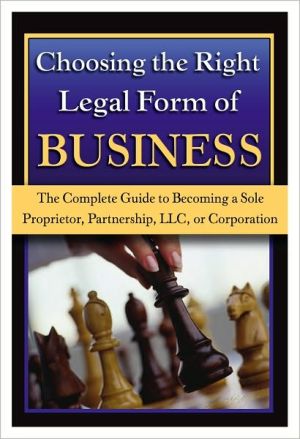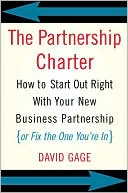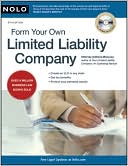Choosing the Right Legal Form of Business: The Complete Guide to Becoming a Sole Proprietor, Partnership, LLC, or Corporation
According the United States Small Business Administration’s most recently released date, there are more than 9 million small businesses in the United States and almost 250,000 new ones started every year. Of those new businesses, half will fail in the first 12 months and part of that failure is due to the lack of information about how to start and develop that business. Without the right legal form of business, you may end up paying too much in taxes, failing to comply with certain laws, or...
Search in google:
According the United States Small Business Administration’s most recently released date, there are more than 9 million small businesses in the United States and almost 250,000 new ones started every year. Of those new businesses, half will fail in the first 12 months and part of that failure is due to the lack of information about how to start and develop that business. Without the right legal form of business, you may end up paying too much in taxes, failing to comply with certain laws, or miss out on certain breaks that you deserve. This book provides you with a complete guide, discussing all four major forms of business, which one is right for you, and how your decision may affect you in the future.The first thing you will read about is the list of non-legal issues you need to deal with before you start the business creation process. In addition, you will learn which form of business is ideal for your particular situation with a short overview of each type, a comparison of what each offers, and how the legal implications of each might apply to you. You will learn specifically how to choose between an LLC and a corporation in instances where it might not be immediately clear which is best for you. You will also learn which special business structures are best suited to your needs if you do not fit into any of the four primary categories.The process of structuring a partnership is outlined, along with how to create a written agreement and how to change a partnership after the business has been created. You will also learn how to create a corporation, including the structure you will use, how to establish financing, the compensation you will provide yourself, whether you need a lawyer, the 13 step process of starting and filing your corporation, and what you need to do immediately afterwards. The number of members needed to create an LLC is provided as well, along with how to structure management and determine financing and compensation. Hours of careful interviews were conducted with successful small business owners and legal experts to help create a comprehensive collection of materials that will guide you through the processes above, as well as how to handle transition of ownership and the extended process of naming your business – including the legal implications of this process, what you need to know about trademarks and service marks, how to protect your own trademarks, and where to do name searches. The licensing and permit processes, as well as the tax structures for each business type, are included for federal, state, and local laws, while additional information is provided on how to build your home-based business as opposed to one in a physical location. If you are looking to create a new business and do not know which format is best for your needs, this book will walk you through each step of the selection process, making sure your new business meets all applicable laws and regulations.
Foreword 11Introduction 15Chapter 1 Before Starting Your Business 21Location 21Entrepreneurial Skills 22Time Management 24Choosing a Business 26Your business name 27Financial considerations 30Working with professionals 31Business Plan 33Marketing Plan 35Sales 36Advertising 37Chapter 2 Overview of Business Structures 41Sole Proprietorships 41Partnerships 42Limited Liability Companies (LLCs) 42Corporations 43Other Legal Entities 43Limited partnership 44Registered limited liability partnership (RLLP) 44Comparison Chart 45Chapter 3 Sole Proprietorships 49Tax Considerations 50Legal Implications 51Operating a Sole Proprietorship 52Advantages and disadvantages 52Chapter 4 Partnerships 57Getting Started 59Step 1 Options for where to organize a partnership 60Step 2 Choosing your partnership's name 61Step 3 Using an attorney 63Step 4 Assess ownership and make distributions 65Step 5 Establish the management structure and select managers 68Step 6 Write the partnership agreement 69Step 7 Get an employer identification number 70Tax Considerations 71Legal Implications 73Advantages and Disadvantages 74Limited Partnerships 76Registered Limited Liability Partnerships (RLLPs) 79Chapter 5 LLCs 87Getting Started 90Step 1 Choose where to organize 90Step 2 Decide on the name for your LLC 92Step 3 Registering your agent 92Step 4 Decide to organize yourself or use an attorney 94Step 5 The LLC ownership 96Step 6 Draft the articles of organization 97Step 7 Assemble your LLC kit and seal (optional) 98Step 8 Determine the management structure and select managers 100Step 9 Creating your operating agreement 102Step 10 Obtain and employer identification number 105Tax Considerations 105Operating an LLC 109Meetings 111The membership ledger and transfer of shares 114Requirements for annual reporting 115Amending articles of organization and operating agreement 115Advantages and disadvantages 116Foreign LLCs 118Businesses That Can Take Advantage of LLCs 118Businesses That May Not Take Advantage of an LLC Entity 121Chapter 6 Corporations 123General Overview 123Corporation management 125S Corporation 126Effects on finances and taxes of an S corporation tax election 129S corporation election 133Capital for a Corporation 134Public offerings 13513 Steps to Incorporation 136Step 1 Decide where to incorporate 137Step 2 Select your corporate name 140Step 3 Choose the type of corporation 142Step 4 Select the registered agent 143Step 5 Decide to do it yourself or hire an attorney 144Step 6 Select the stock structure 146Step 7 Write and file the articles of incorporation 149Step 8 Create your corporate kit and seal 151Step 9 Name your corporation's directors 152Step 10 Write you corporation's bylaws 154Step 11 Call a directors' organizational meeting 155Step 12 Obtain an employer identification number 156Step 13 Maintain your corporation 157Tax Considerations 157Operating a Corporation 161Annual meetings 164Advantages and disadvantages 171Chapter 7 Changing your Business Structure 175Determining the Right Time for a Change 175Changing your Tax Structure 176Changing a Partnership to an LLC 179Converting a Partnership to a Corporation 184From a general partnership to a corporation 188From a limited partnership to a corporation 190Converting a Sole Proprietorship or Partnership to an LLC 191Converting a Sole Proprietorship to a Partnership 192Legal procedures 193Tax consequences of conversion 194Procedures for a tax filing 195Changing a Sole Proprietorship to an LLC 196Legal procedures 196Income tax consequences of conversion 198Tax-filing procedures 199Self-employment taxes 199Converting a Sole Proprietorship to a Corporation 200Legal procedures 201Effects of income tax conversion 203Tax-filing procedures 204Converting an LLC to a Corporation 205Legal procedures 206Effects on income tax of conversion 208Tax-filing procedures 209Changing an LLC to a Partnership 209Legal procedures 210Effects on income taxes 211Changing an LLC to a Sole Proprietorship 212Effects on income tax 213Chapter 8 Other Considerations 219Operating a Home-based Business 219Doing Business in Other States 221Qualifying 225Post-qualification duties 228Failing to qualify a business 230Lawsuits in Other States 233Fighting Personal Jurisdiction 245Chapter 9 Exit Plans 253Why you Need a Plan 253Dissolving and Liquidating a Corporation 255Effects on income tax of dissolution 255Sale of assets 256Selling stock 257A corporation-to-corporation sale 258Types of Reorganizations 259Reorganization procedures 259Effects on income tax of corporate reorganizations 261Dissolving a Partnership 262Dissolution of an LLC 263Conclusion 267Appendix: State Web Sites and SBA Offices 269Small Business Administration (SBA) Offices 272Bibliography 279Author Biography 281Index 283







